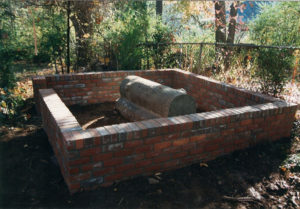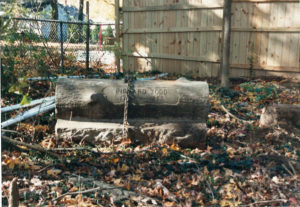Looking Back – and Ahead – at the Todd Cemetery Memorial
By Jack White, outgoing VHCA Board President
The homeowners who destroyed the Todd Cemetery Memorial filed responses last week to the legal assertions that VHCA and the Todd family made in our lawsuit. You may read our filing here.
These responses are public and filed under oath; you may read them here. Their responses are numerical and do not show the assertions to which they are responding, so fans of this will have to open both and go one by one.
As you would expect, they have no comment on many assertions; others they contest or label irrelevant. And they filed a motion for dismissal and an assertion that we had trespassed by walking up the driveway that has been in use since the house was first built there. Neither claim has merit; some form of both were anticipated.
About the actual content of the suit – the easement, the fence, the destruction – there is no need to debate or wonder any longer about the following points:
VHCA asserted – and they acknowledge – that a public easement exists on the property. (As our attorney pointed out and offered to share with them a year ago, it’s referenced on the signed plat in the Fulton County property records.)
VHCA asserted – and they do not contest – that the homeowners erected a new fence that blocked public access to the memorial.
VHCA asserted – and they acknowledge – that they made an agreement to place a sign on the fence inviting visitors to enter through their gate during daylight hours to visit the memorial and to be respectful of the property owners.
VHCA asserted – and they admit – that they hired a contractor who destroyed the monument in December of last year.
VHCA asserted – and they acknowledge – that they were not truthful when they claimed that “vandals” were responsible for the destruction.
The destruction of the memorial presented itself as a series of questions that had to be answered.
Let’s look at the how the 2015-16 VHCA board analyzed them.
- Was the monument worth preserving? What was its place in the history of VaHi?
- Was there a significant underlying principle at play here that compelled our attention?
- Was there another entity that realistically could have taken on the issue?
- Does being a resident of VaHi immunize you from legal action by VHCA?
- Did the Civic Association have the resources to make this legal objection? Would the fight ruin existing programs or compromise our Associations’ ability to meet its legal obviations?
- Did we rush into this without trying every reasonable alternative before filing suit?
Was the monument worth preserving?
The monument honors the family of the settlers who moved here after the state bought the land from the Creek Indians and sold it in an 1821 lottery. This monument’s lot and its adjacent one to the west were the last pieces of a much larger Todd tract that were historic family burial sites. The monument was created as part of a court agreement that permitted the development of these last two lots in the late 1980’s.
The (now destroyed ) physical monument consisted of an historic marker placed on the cemetery site in the late 1920s to honor the original settlers, Richard and Martha Todd. That memorial marker was surrounded by a wrought iron fence set atop several courses of brick.
Both nearby neighbors and the Virginia-Highland Civic Association were participants in the process that created and accepted the agreement. VaHi residents Craig Strain and Gail Nowak wrote about it in The Voice in 1980 and 1984 and organized a site cleanup in the latter years, before the monument’s establishment. Former Ponce de Leon Terrace resident Carl Hartrampf chaired a VHCA Todd Cemetery Committee in the spring of 1986; he, Jerry Bright, and other nearby residents advocated for very specific conditions and outcomes in detailed letters and reports they exchanged with Sam Dickson, who developed the easement. Noted Atlanta historian Franklin Garrett visited the site.
It has a documented record of citizen and Association involvement from that period, and several local historians of the last two decades have written about it as well, including in Arcadia Publishing’s Images of America: Virginia-Highland, which came out five years ago.
Whether one thinks history or preservation matters or not, it is clear that the 2105-16 Board was hardly alone in valuing the monument.
Other than the historic value, was there a significant underlying principle at play here that compelled out attention?
The deliberate destruction of the monument created a completely different issue. The Board considered it an affront to the community and found it impossible to ignore or accept on many levels. Aside from the plain ugliness of the act, it places the question of the rule of law on the table. Condoning it would have made a mockery of our efforts to demand that other citizens – developers or residents – have to obey the law. The Civic Association is – and has to be – a group that believes in order, lawful process, and good will among our citizens.
Was there another entity that realistically should or could have credibly taken on the issue?
Given the unusual circumstances of this case – the destruction of a significant public monument on private property and absent a police report – APD saw no option other than a civil remedy. We asked several preservation nonprofits, all of whom were astonished at the act but also had full plates of their own. We contacted and spoke with family members; as one would have expected, they were angry and disappointed and supported this battle in many ways – emotionally, financially, and by their presence at the mediation.
We would have loved someone to swoop in and take this on. As no one could identify who that might be, the simple choice that this Board faced was to act or to walk away.
It was a monument in our neighborhood and with a history created by our citizens over three decades, and it was our battle. We embraced it.
Does being a resident of VaHi immunize you from legal action by VHCA?
The Board has faced off with residents in court proceedings before. It hasn’t happened often, but the Board has been in court several times with local business owners – several of them quite familiar – who were residents.
It seems silly on its face to suggest that VHCA should vigilantly demand compliance with a formal agreement that a business basement be used only for storage or that a warming device be excluded from a yogurt shop, but ignore the (admitted) destruction of a cemetery memorial. (All examples are real, and VHCA has fought for all these points in the last five years.)
Did the Civic Association have the resources to mount a legal objection? Can the Association meet its obligations?
We did and we are confident it can and will. The Association has paid all its bills, matched Councilmember Wan’s matching offer of $19,000 for security cameras, handed out another year of supporting grants to community organizations, and ends the Board year with its customary six-figure reserve. Record Tour of Homes revenues await only half-decent weather.
We have formally asserted a demand – and believe that simple justice, logic, and law compel – the recovery of our legal fees expended since the destruction of the monument. If ever a set of facts and behaviors supported such an outcome, these are the ones.
Did we rush into this? Did we try every reasonable alternative before filing suit?
We took at face value their claim that no easement existed and paid for our own lawyer to verify its existence and offer his case material to them, along with evidence of court rulings validating such easements. Our lawyer negotiated at our expense a good-faith solution that included our paying for a sign reminding visitors to be courteous and respectful. (No one has ever reported any other sorts of behaviors, as it happens.) We considered that money well spent; these are our neighbors.
When we were faced with the memorial’s destruction and the homeowners’ denial of responsibility, we slowly gathered facts and reports and continued to try to negotiate. When they asserted that we were harassing them (absent any evidence) and twice threatened to sue us personally, we countered with an offer of mediation.
The legal and financial logic for their pursuing a settlement was overwhelming, as was pointed out to us repeatedly. It took their walking away from the mediation process to convince us to sue. Whatever this board was, it wasn’t rash or rushed.
Their persistent refusal to admit that they were responsible (until they had to write under oath) pushed our legal costs toward the maximums described by our attorney and mocked our assumption and belief that our acting in executive session would increase the probability of their settling privately rather than being embarrassed publicly. Whatever their motivations, they have delayed and stalled for six months.
Paying for this made us shake our heads; we can all think of great things to do with the money. That’s why we are determined to see it returned by those who knew what they had done and ran the bills up; our lawyer will do everything possible toward that end.
But if it isn’t – and we like our chances – we believe the battle had to be fought. This neighborhood association has acted on principle since its founding. We love trees and green spaces but we don’t just plant them; we fight for policy that protects them. We appreciate improved homes, but we’re not afraid to take on improper development. We love having new citizens in our neighborhood, but we also like to protect our historic structures.
We’ve always fought battles that were based on principle, and I hope we always will. It’s a key part of what has made this neighborhood a unique place.


